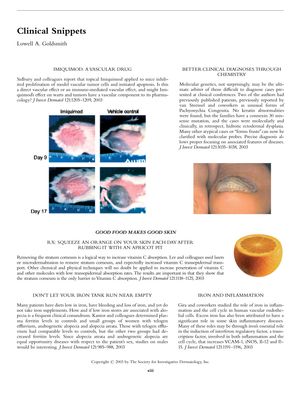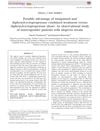Clinical Snippets
November 2003
in “Journal of Investigative Dermatology”

TLDR Topical Imiquimod may fight vascular tumors by affecting blood vessels or the immune system, low iron might be linked to some hair loss, removing the top skin layer helps vitamin C get in, genetic testing helps diagnose skin conditions, and too much iron could worsen skin inflammation.
Sidbury and colleagues discovered that topical Imiquimod inhibited the proliferation of vascular tumor cells and induced apoptosis in mice, raising questions about whether its effects on warts and tumors are due to direct vascular effects or immune-mediated vascular effects. Kantor and colleagues found that women with androgenetic alopecia and alopecia areata had decreased plasma ferritin levels, unlike those with telogen effluvium who had comparable levels to controls, suggesting a potential link between iron deficiency and certain types of alopecia. Lee and colleagues demonstrated that removing the stratum corneum increased vitamin C transepidermal transport, indicating that the stratum corneum is the main barrier to vitamin C absorption. Molecular genetics was shown to be useful in diagnosing difficult cases, as demonstrated by the reclassification of cases previously thought to be Pachyonychia Congenita but were actually hidrotic ectodermal dysplasia due to a connexin 30 missense mutation. Gira and coworkers studied the role of iron in inflammation and the cell cycle, finding that excess iron may contribute to skin inflammatory diseases through its role in inducing interferon regulatory factor, which affects various inflammatory and cell cycle-related proteins.
View this study on jidonline.org →
Related

research Possible advantage of imiquimod and diphenylcyclopropenone combined treatment versus diphenylcyclopropenone alone: An observational study of nonresponder patients with alopecia areata
Combining imiquimod with diphenylcyclopropenone may improve treatment outcomes for alopecia areata patients who don't respond to diphenylcyclopropenone alone.